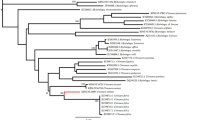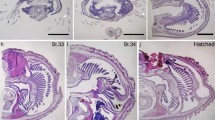Abstract
Anadara kagoshimensis (Tokunaga, 1906) is an alien bivalve mollusk that has successfully colonized the Black Sea and the Sea of Azov despite a significantly lower salinity level of these waters compared to its native region. The morphological and morphometric characteristics of erythrocytes from A. kagoshimensis during adaptation to hypo- and hyperosmotic experimental conditions were analyzed by light microscopy. The control group of mollusks was maintained at 18‰ salinity. Experimental groups were maintained at the salinity levels of 8, 14, 35, and 45‰. A decreased salinity level was obtained by diluting seawater with distilled water at a rate of 1.5 ± 0.5‰ per day. An increased salinity was obtained by addition of sea salt to an aquarium at a rate of 2.5 ± 0.5‰ per day. The exposure period was 2 days. The natural salinity range of A. kagoshimensis was found to fall within 14—35‰. No significant cell morphology changes were observed under such conditions. At the same time, exposure of the mollusks to the environmental salinity of 8 and 45‰ caused an obvious stress expressed via appearance of cell anomalies and changes in the linear characteristics of erythrocytes. At the same time, no cell lysis was observed, and the values of the specific surface area and the nuclear-cytoplasmic ratio remained unchanged. The results of the study indicate the ability of the mollusk to survive for some time in an aquatic environment with extremely low or high salinity.



Similar content being viewed by others
REFERENCES
Andreenko, T.I., Soldatov, A.A., and Golovina, I.V., Adaptive reorganization of metabolism in the bivalve mollusk Anadara inaequivalvis Bruguiere under experimental anoxia, Doklady Natsional’noi Akademii Nauk Ukrainy, 2009, no. 7, pp. 155–160.
Bregante, M., Carpaneto, A., Piazza, V., Sbrana, F., Vassalli, M., Faimali, M., and Gambale, F., Osmoregulated chloride currents in Hemocytes from Mytilus galloprovincialis, PLoS One, 2016, vol. 11, no. 12, p. e0167972. https://doi.org/10.1371/journal.pone.0167972
Cossins, A.R., and Gibson, J.S., Volume-sensitive transport systems and volume homeostasis in vertebrate red blood cells, J. Exp. Biol., 1997, vol. 200, no. 2, pp. 343–352. https://doi.org/10.1242/jeb.200.2.343
Holden, J.A., Pipe, R.K., Quaglia, A., and Ciani, G., Blood cells of the arcid clam, Scapharca inaequivalvis, J. Mar. Biol. Assoc. U. K., 1994, vol. 74, no. 2, pp. 287–299. https://doi.org/10.1017/S0025315400039333
Jackson, P.S., Morrison, R., and Strange, K., The volume-sensitive organic osmolyte-anion channel VSOAC is regulated by nonhydrolytic ATP binding, Am. J. Physiol.: Cell Physiol., 1994, vol. 267, no. 5, pp. C1203–C1209. https://doi.org/10.1152/ajpcell.1994.267.5.C1203
Kiseleva, M.I., Comparative characteristics of benthic communities off the Caucasus coasts, in Mnogoletnie izmeneniya zoobentosa Chernogo morya (Long-Term Changes in the Zoobenthos of the Black Sea), Kiev: Naukova Dumka, 1992, pp. 84–99.
McFarland, K., Donaghy, L., and Volety, A.K., Effect of acute salinity changes on hemolymph osmolality and clearance rate of the non-native mussel, Perna viridis, and the native oyster, Crassostrea virginica, in Southwest Florida, Aquatic Invasions, 2013, vol. 8, no. 3, pp. 299–310. https://doi.org/10.3391/ai.2013.8.3.06
Morello, E.B., Solustri, C., and Froglia, C., The alien bivalve Anadara demiri (Arcidae): A new invader of the Adriatic Sea, Italy, J. Mar. Biol. Assoc. U. K., 2004, vol. 84, no. 5, pp. 1057–1064. https://doi.org/10.1017/S0025315404010410h
Novitskaya, V.N. and Soldatov, A.A., Erythroid elements of the hemolymph in Anadara inaequivalvis (Mollusca: Arcidae) under experimental anoxia: Functional and morphometric characteristics, Morskoi Ekologicheskii Zhurnal, 2011, vol. 10, no. 1, pp. 56–64.
Novitskaya, V.N., and Soldatov, A.A., Features of the functional morphology of erythroid elements of the hemolymph of the bivalve mollusk Anadara inaequivalvis, Black Sea, Gidrobiol. Zh., 2013, vol. 49, no. 4, pp. 69–77.
Poutiers, J.M., Gastropods, in FAO Species Identification Guide for Fishery Purposes. The Living Marine Resources of the Western Central Pacific, 1998, vol. 1, pp. 363–648.
Revkov, N.K., Abaza, V., Dumitrache, C., Todorova, V., Konsulova, T., Mickashavidze, E., et al., The state of zoobenthos, Commission on the Protection of the Black Sea Against Pollution, 2008, pp. 243–290.
Shiganova, T.A., Alien species in the ecosystems of the southern inland seas of Eurasia, Extended Abstract of Doctoral (Biol.) Dissertation, Moscow, 2009.
Solan, M., and Whiteley, N., Stressors in the Marine Environment: Physiological and Ecological Responses; Societal Implications, Oxford University Press, 2016. https://doi.org/10.1093/acprof:oso/9780198718826.0-01.0001
Soldatov, A., Kukhareva, T., Morozova, V., Richkova, V., Andreeva, A., and Bashmakova, A., Morphometric parameters of erythroid hemocytes of alien mollusc Anadara kagoshimensis under normoxia and anoxia, Ruthenica, 2021, vol. 31, no. 2, pp. 77–86. https://doi.org/10.35885/ruthenica.2021.31(2).3
Soldatov, A.A., Kukhareva, T.A., Andreeva, A.Y., and Efremova, E.S., Erythroid elements of hemolymph in Anadara kagoshimensis (Tokunaga, 1906) under conditions of the combined action of hypoxia and hydrogen sulfide contamination, Russ. J. Mar. Biol., 2018, vol. 44, no. 6, pp. 452–457. https://doi.org/10.1134/S1063074018060111
Torre, A., Trischitta, F., Corsaro, C., Mallamace, D., and Faggio, C., Digestive cells from Mytilus galloprovincialis show a partial regulatory volume decrease following acute hypotonic stress through mechanisms involving inorganic ions, Cell Biochem. Funct., 2013, vol. 31, no. 6, pp. 489–495. https://doi.org/10.1002/cbf.2925
Zhang, M., Li, L., Liu, Y., and Gao, X., Effects of a sudden drop in salinity on immune response mechanisms of Anadara kagoshimensis, Int. J. Mol. Sci., 2019, vol. 20, no. 18, p. 4365.
Zhivoglyadova, L.A., Revkov, N.K., Frolenko, L.N., Afanas’ev, D.F., The expansion of the bivalve mollusk Anadara kagoshimensis (Tokunaga, 1906) in the Sea of Azov, Russ. J. Biol. Invasions, 2021, vol. 12, no. 2, pp. 192–202. https://doi.org/10.1134/S2075111721020120
Zolotnitskaya, R.P., Methods of hematological research, in Laboratornye Metody Issledovaniya v Klinike: Spravochnik (Laboratory Research Methods in the Clinic: Handbook), Moscow: Meditsina, 1987, pp. 106–148.
Funding
The study of the effect of a hypoosmotic load on the hemocytes of A. kagoshimensis was carried out within the framework of the State Assignment of the Federal Research Center Institute of Biology of the Southern Seas “Principles of the Immune System Organization in Food Hydrobionts and the Study of the Effect of Environmental Factors on the Functioning of Their Defense Systems” (theme no. 121102500161-4).
The study of the effect of a hyperosmotic load on the hemocytes of A. kagoshimensis was carried out within the framework of the State Assignment of the Federal Research Center Institute of Biology of the Southern Seas “Functional, Metabolic, and Toxicological Aspects of the Occurrence of Hydrobionts and Their Populations in Biotopes Differing in Their Physicochemical Regimes” (theme no. 121041400077-1).
Author information
Authors and Affiliations
Corresponding authors
Ethics declarations
ETHICS APPROVAL AND CONSENT TO PARTICIPATE
All experimental protocols were performed in accordance with the EU guidelines on the use of animals for experimental and other scientific purposes (86/609/CEE) and in compliance with the rules approved by the Order of the Presidium of the USSR Academy of Sciences no. 12000-496 (April 2, 1980) and the Order of the USSR Ministry of Higher Education no. 22 (September 13, 1984). All efforts were made to use the minimum number of animals required to obtain reliable scientific data.
CONFLICT OF INTEREST
The authors of this work declare that they have no conflicts of interest.
Additional information
Translated by N. Statsyuk
Publisher’s Note.
Pleiades Publishing remains neutral with regard to jurisdictional claims in published maps and institutional affiliations.
Rights and permissions
About this article
Cite this article
Kukhareva, T.A., Rychkova, V.N., Soldatov, A.A. et al. Adaptation of Anadara kagoshimensis (Tokunaga, 1906) to Hypo- and Hyperosmotic Environment: Hemocyte Response. Russ J Biol Invasions 14, 581–587 (2023). https://doi.org/10.1134/S2075111723040094
Received:
Revised:
Accepted:
Published:
Issue Date:
DOI: https://doi.org/10.1134/S2075111723040094




